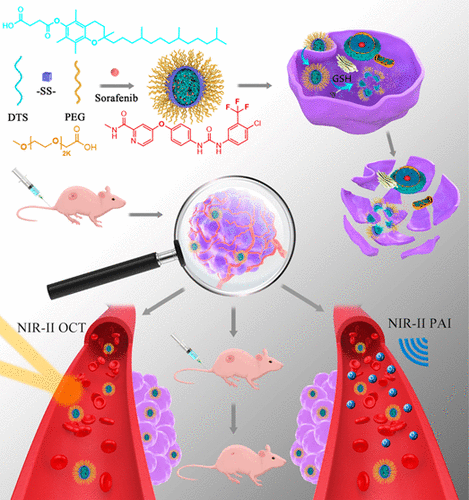当前位置:
X-MOL 学术
›
ACS Appl. Polym. Mater.
›
论文详情
Our official English website, www.x-mol.net, welcomes your
feedback! (Note: you will need to create a separate account there.)
NIR-II Dual-Modal Optical Coherence Tomography and Photoacoustic Imaging-Guided Dose-Control Cancer Chemotherapy
ACS Applied Polymer Materials ( IF 4.4 ) Pub Date : 2020-03-30 , DOI: 10.1021/acsapm.0c00155 Yubin Liu 1, 2 , Mengze Xu 1 , Yunlu Dai 1 , Qi Zhao 1 , Lipeng Zhu 1 , Xiaowen Guan 1 , Gang Li 1 , Sihua Yang 3 , Zhen Yuan 1, 4
ACS Applied Polymer Materials ( IF 4.4 ) Pub Date : 2020-03-30 , DOI: 10.1021/acsapm.0c00155 Yubin Liu 1, 2 , Mengze Xu 1 , Yunlu Dai 1 , Qi Zhao 1 , Lipeng Zhu 1 , Xiaowen Guan 1 , Gang Li 1 , Sihua Yang 3 , Zhen Yuan 1, 4
Affiliation

|
In this study, an organic nanodrug delivery platform was constructed as a biocompatible cancer chemotherapeutic system, in which clinically approved sorafenib was loaded in the redox-responsive polymeric micelles, enabling dose-control release of drug to cancer tissues. In addition, visualizing tumor microenvironment changes is also essential for cancer chemotherapy, which can provide a priori and feedback control of drug delivery with reduced side effects. Therefore, second near-infrared window (NIR-II) dual-modal optical coherence tomography (OCT) and photoacoustic imaging were performed for real-time visualization of the tumor microenvironment changes in vivo during chemotherapy. In particular, the tumor angiogenesis, the vascular networks density change, and the quantitative total hemoglobin concentration and oxygen saturation of cancer tissues were carefully characterized for individually optimized cancer chemotherapy. It was discovered that the final tumor growth inhibition by dual-modal imaging-guided dose-control chemotherapy can be up to 94.6% during a 30-day treatment, which is much higher than the efficacy from presently utilized tumor treatment options. Herein, the combination of a redox-responsive theranostic agent and NIR-II dual-modal OCT and photoacoustic imaging paved a novel avenue both for guiding dosage control of antiangiogenic drugs to avoid toxic effects and for monitoring and inspecting tumor microenvironment changes while substantially enhancing tumor penetration and antitumor efficacy.
中文翻译:

NIR-II双模态光学相干断层扫描和光声成像指导剂量控制癌症化疗。
在这项研究中,构建了有机纳米药物递送平台作为生物相容性癌症化学治疗系统,其中临床批准的索拉非尼被装载在氧化还原反应性聚合物胶束中,从而能够控制药物向癌症组织的释放。另外,可视化肿瘤微环境变化对于癌症化学疗法也是必不可少的,它可以提供先验和反馈控制药物递送,同时减少副作用。因此,进行了第二次近红外窗口(NIR-II)双模态光学相干断层扫描(OCT)和光声成像,以实时可视化化疗期间体内的肿瘤微环境变化。特别是肿瘤的血管生成,血管网络密度的变化,并仔细表征了癌组织的定量总血红蛋白浓度和氧饱和度,以进行单独优化的癌症化疗。已发现在30天的治疗过程中,双模式影像引导的剂量控制化学疗法对肿瘤的最终生长抑制率可高达94.6%,远高于目前使用的肿瘤治疗方案的疗效。在本文中,氧化还原反应性治疗药物和NIR-II双模式OCT和光声成像的结合为指导抗血管生成药物的剂量控制以避免毒性作用以及监测和检查肿瘤微环境变化同时显着增强肿瘤铺平了一条新途径。渗透和抗肿瘤功效。已发现在30天的治疗过程中,双模式影像引导的剂量控制化学疗法对肿瘤的最终生长抑制率可高达94.6%,远高于目前使用的肿瘤治疗方案的疗效。在本文中,氧化还原反应性治疗药物和NIR-II双模式OCT和光声成像的结合为指导抗血管生成药物的剂量控制以避免毒性作用以及监测和检查肿瘤微环境变化同时显着增强肿瘤铺平了一条新途径。渗透和抗肿瘤功效。已发现在30天的治疗过程中,双模式影像引导的剂量控制化学疗法对肿瘤的最终生长抑制率可高达94.6%,远高于目前使用的肿瘤治疗方案的疗效。在本文中,氧化还原反应性治疗药物和NIR-II双模式OCT和光声成像的结合为指导抗血管生成药物的剂量控制以避免毒性作用以及监测和检查肿瘤微环境变化同时显着增强肿瘤铺平了一条新途径。渗透和抗肿瘤功效。
更新日期:2020-03-30
中文翻译:

NIR-II双模态光学相干断层扫描和光声成像指导剂量控制癌症化疗。
在这项研究中,构建了有机纳米药物递送平台作为生物相容性癌症化学治疗系统,其中临床批准的索拉非尼被装载在氧化还原反应性聚合物胶束中,从而能够控制药物向癌症组织的释放。另外,可视化肿瘤微环境变化对于癌症化学疗法也是必不可少的,它可以提供先验和反馈控制药物递送,同时减少副作用。因此,进行了第二次近红外窗口(NIR-II)双模态光学相干断层扫描(OCT)和光声成像,以实时可视化化疗期间体内的肿瘤微环境变化。特别是肿瘤的血管生成,血管网络密度的变化,并仔细表征了癌组织的定量总血红蛋白浓度和氧饱和度,以进行单独优化的癌症化疗。已发现在30天的治疗过程中,双模式影像引导的剂量控制化学疗法对肿瘤的最终生长抑制率可高达94.6%,远高于目前使用的肿瘤治疗方案的疗效。在本文中,氧化还原反应性治疗药物和NIR-II双模式OCT和光声成像的结合为指导抗血管生成药物的剂量控制以避免毒性作用以及监测和检查肿瘤微环境变化同时显着增强肿瘤铺平了一条新途径。渗透和抗肿瘤功效。已发现在30天的治疗过程中,双模式影像引导的剂量控制化学疗法对肿瘤的最终生长抑制率可高达94.6%,远高于目前使用的肿瘤治疗方案的疗效。在本文中,氧化还原反应性治疗药物和NIR-II双模式OCT和光声成像的结合为指导抗血管生成药物的剂量控制以避免毒性作用以及监测和检查肿瘤微环境变化同时显着增强肿瘤铺平了一条新途径。渗透和抗肿瘤功效。已发现在30天的治疗过程中,双模式影像引导的剂量控制化学疗法对肿瘤的最终生长抑制率可高达94.6%,远高于目前使用的肿瘤治疗方案的疗效。在本文中,氧化还原反应性治疗药物和NIR-II双模式OCT和光声成像的结合为指导抗血管生成药物的剂量控制以避免毒性作用以及监测和检查肿瘤微环境变化同时显着增强肿瘤铺平了一条新途径。渗透和抗肿瘤功效。











































 京公网安备 11010802027423号
京公网安备 11010802027423号